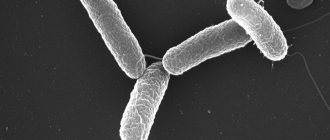Salmonellosis is a common intestinal infection. It mainly affects the organs of the gastrointestinal tract (GIT), namely the small intestine and stomach. Pathogenic microbes enter the human body mainly through products of animal origin.
The disease is characterized by severe intoxication and dehydration. The largest number of cases of infection with this infectious disease are recorded in the summer. In order to prevent or minimize the likelihood of infection, it is important to know how salmonellosis is transmitted.
What is salmonellosis
Salmonellosis is undoubtedly one of the dangerous and serious diseases from the category of intestinal infections and it occurs quite often in our time. It is caused by pathogenic bacteria of the genus Salmonella.
An acute inflammatory process in the intestines leads to diarrhea and vomiting, which provoke severe dehydration, and the waste products of the microbe form severe intoxication. The infection can occur with a clinical picture similar to typhus, or with manifestations of blood poisoning. Most people become infected with salmonellosis through food, and outbreaks are often recorded among groups of children or adults.
Recommendations for parents on feeding their child after discharge home
After discharge, the child’s diet can be gradually expanded. At this stage, the child can return to his usual amount of food. But you should exclude hard-to-digest foods, fatty and salty foods from your diet.
And you also need to be careful when introducing vegetables and fruits into your diet. Consumption of cabbage, legumes, cucumbers, tomatoes, potatoes, tangerines, pears, plums and grapes is not recommended.
You can include lean meats (turkey, chicken, veal, rabbit), low-fat cottage cheese, and egg yolk in your diet.
A baby who is breastfed should be fed on demand, but a baby who is bottle-fed should be fed according to his usual schedule.
The causative agent of salmonellosis
Salmonella is a separate genus of rod-shaped bacteria. They are anaerobes that are resistant to unfavorable environmental factors. They can survive in water for up to 5 months, in soil for up to 1 year or more, in frozen meat and poultry carcasses for up to 1 year or more. They can survive in dairy products for up to 20 days, in cheeses they can survive up to a year, on egg shells and egg powder for up to 3 weeks.
The bacterium Salmonella typhimurium under a microscope. Photo: wikipedia.org
Salmonella does not tolerate heat treatment; raising the temperature above 70 ° C kills them within 5 minutes. But they can withstand boiling inside a piece of meat if it is poorly cooked. If these are eggs, the bacteria die in 4 minutes when boiled. In meat and dairy products (not thermally processed) they are well preserved and multiplied, without spoiling the appearance and taste of the products.
Salmonella can withstand salting and smoking; when frozen, the lifespan of the pathogen increases. These bacteria are also dangerous because over many years they have acquired resistance to antibiotics and disinfectant solutions.
Outpatient or inpatient?
Outpatient treatment of salmonellosis is carried out for mild cases of the disease after 1 year. And also if the clinical symptoms are not pronounced and do not affect the child’s well-being.
Hospitalization is indicated for moderate severity of salmonellosis and for severe forms of the disease. Children in their first year of life are hospitalized first, regardless of the severity of the disease. Children with weakened immune systems and associated complications should be treated in a hospital.
Treatment of the disease in a hospital takes on average 10–14 days. Discharge is made after the disappearance of clinical symptoms and normalization of laboratory test results.
A child is admitted to preschool educational institutions after a negative test for the presence of a pathogen. As a rule, within a month after infection, the child is a carrier of the bacterium.
Recommended video:
Routes of transmission of salmonellosis in adults
The main source of salmonella for humans is poultry, meat of domestic and wild animals, and eggs. Animals themselves can be carriers or also suffer from the infection. A person can become infected when treating sick animals, when slaughtering poultry or livestock, or if they eat contaminated foods. Sometimes the person himself is the target for the spread of bacteria. It can spread the infection for 3 weeks; in rare cases, longer carriage is possible.
The infection is mainly transmitted through dirty hands and food; dishes with raw eggs, dairy and meat products are especially dangerous in terms of contamination; drinking water becomes a less common source of infection. In organized groups, the contact path, from sick people to healthy people, is also dangerous.
Forms of salmonellosis in adults
Depending on the clinical picture of the disease and the extent of its spread, doctors distinguish several forms of the infectious process:
- gastrointestinal (mainly the stomach and intestines are affected);
- generalized (all organs and tissues suffer);
- bacterial excretion (no symptoms, but the pathogen is cultured).
In the gastrointestinal form, experts identify several variants of the course of the disease:
- predominantly gastric (mainly the stomach is affected);
- gastroenteric (the stomach and small intestine are affected);
- gastroenterocolitic (all parts of the digestive system from the stomach to the colon are affected).
The generalized form of salmonellosis can occur in two types - typhus-like, with a clinical picture similar to typhoid fever, and septic.
The release of bacteria can be acute, transient or chronic.
Possible complications of salmonellosis
Most often, complications of the disease occur in septic and typhus-like forms. This is due to the massive spread of the pathogen in the body.
But with the classic course of the disease, complications can also develop, but they are less common.
- Dehydration. This complication occurs especially often in young children. The child becomes lethargic and does not respond to external stimuli. The skin becomes dry to the touch, the child refuses to drink. Urination stops.
- Hepatitis.
- Meningitis.
- Pneumonia.
- Arthritis.
- Osteomyelitis.
- Otitis.
- Pericarditis.
- Peritonitis.
- Bleeding.
- Pyelonephritis.
- Development of dysbacteriosis.
- Sepsis (blood poisoning).
Symptoms of salmonellosis in adults
The incubation period (from the moment the bacteria enters the body until the first manifestations) lasts from several hours to 2 days. Symptoms will depend on the form of the disease, age and other characteristics of the body.
The most common type of salmonellosis occurs. It is typically characterized by the presence of intoxication (due to the waste products of bacteria and the development of the inflammatory process in the body) and a disorder of water-salt metabolism. The disease begins with acute manifestations:
- the temperature rises, sometimes to extremely high values;
- signs of intoxication appear - weakness, aching muscles, joints, headache.
A little later, pain appears in the abdominal area, mainly in the stomach, near the navel, and in the right iliac region. It has the character of painful spasms, accompanied by severe nausea and repeated vomiting. Diarrhea quickly appears, it is watery, with foam, has a greenish tint and a bad smell. Depending on the severity of the condition, diarrhea and vomiting may be rare or intractable. Loss of fluid through stool and vomit causes severe dehydration.
On a note
How to cope with dysentery: advice from doctors
The patient's skin is pale and bluish. The tongue is covered with a thick coating, dry, the abdomen is swollen, and upon palpation there is pain and rumbling. The pulse also increases, blood pressure decreases, and the volume of urine excreted decreases; if dehydration is severe, there may be cramps in the leg muscles.
If salmonellosis occurs as gastroenterocolitis, on days 2–3 the volume of stool decreases, and mucus with blood streaks may be released. The abdomen is painful when palpated; there may be a false urge to defecate with pain.
The gastric variant is rare; nausea with vomiting, intoxication, pain in the epigastric region, and no diarrhea are typical.
The generalized form may resemble typhoid fever in its course. The first to appear are symptoms from the stomach and intestines (vomiting, diarrhea), then they gradually subside, replaced by signs of toxicosis - with fever, weakness, headache. In this case, the temperature increase can be either constant or in the form of waves. Minor hemorrhages may appear on the skin, and the spleen and liver may become enlarged.
In the septic variant, digestive symptoms also appear first, followed by fever with palpitations, chills, severe sweating, the liver and spleen become enlarged, foci of suppuration appear in the kidneys, lungs, bladder, endocarditis, and phlegmon. After an illness, patients can shed salmonella for up to a month. If this process is delayed, it is considered that bacterial excretion has become chronic.
Features of infection from humans and main signs
Infection can also occur from a person with salmonellosis. A carrier of salmonella is also someone who has already had the disease. It is still contagious to others. When infected with salmonellosis from person to person, contact and household transmission of the infection occurs.
The mechanism of infection is characterized by the following stages:
- Live salmonella bacteria enter the human body.
- Salmonella attacks the intestinal walls.
- Bacteria are captured by macrophages, where their active reproduction begins.
- When bacteria die, they release endotoxin, which affects the blood vessels and nerve endings of the intestine. This, in turn, favors the spread of salmonella.
- Bacteria penetrate the lymph nodes and blood vessels. The infection spreads throughout the body through the bloodstream.
- Salmonella multiply in various organs.
- Under the influence of toxins, the human condition is disrupted.
Despite the insidiousness of salmonella, the penetration of bacteria into the body does not always lead to illness. Bacteria enter the stomach before passing into the small intestine. Hydrochloric acid can kill salmonella, or rather, some of it. But people who have diseases associated with impaired secretion of gastric juice are most sensitive to salmonellosis.
If the bacteria have safely passed the gastric barrier, their next refuge is the intestines. There they begin their active destructive activities.
A person with salmonellosis is dangerous to others for the entire duration of his illness. Even for some time after recovery, he continues to excrete bacteria. Despite the fact that there are no symptoms of the disease and the person is in good health, he still continues to excrete salmonella. This period can last up to 3 months or more. A person can be a carrier of salmonella, but not know it. Such latent carriage can last up to 1 year.
The risk of salmonella infection is increased in the following categories of people:
- children under 5 years old;
- aged people;
- people who have had their spleen and stomach removed;
- persons with reduced immunity;
- poultry and farm workers;
- lovers of raw food, especially meat and eggs.
In children, the clinical manifestations of the disease are most severe and have a long course. Often acute salmonellosis in a small child can develop into long-term carriage of the bacteria. Family members caring for a sick child must carefully maintain personal hygiene.
In addition to bacterial excretion, there are two forms of salmonellosis: gastrointestinal and generalized. In the first case, the intestines and stomach are affected. The generalized form is characterized by the involvement of other organs and systems in the pathological process. Usually the disease begins acutely. Symptoms of salmonellosis infection are as follows:
- nausea and vomiting;
- stomach ache;
- frequent profuse loose stools;
- bloating;
- rumbling in the stomach.
Symptoms of intoxication depend on the severity of the disease. In mild cases it is absent. With an average degree, the temperature rises to 39 degrees, the patient is bothered by dizziness and headaches, cramps in the limbs may appear, and aches are felt throughout the body. Severe salmonellosis is characterized by a high temperature of more than 40 degrees, chills, severe weakness and a sharp loss of strength.
Salmonella primarily affects the gastrointestinal tract
Treatment of salmonellosis in adults
It is important to emphasize that even mild forms of salmonellosis require constant medical supervision and full treatment so that the patient does not infect others and provoke an outbreak of infection.
In order to choose the right treatment, you need to confirm the diagnosis and determine the sensitivity of bacteria to antibiotics.
Diagnostics
The basis of diagnosis is an indication of an outbreak of infection, as well as the isolation of bacteria from the body (in vomit and stool). In the septic form, bacteria are also isolated from the blood.
Cultures are carried out to identify bacteria and assess their sensitivity to antibiotics. Serological diagnostics are also performed using various methods - ELISA, RLA or RIA.
The severity of the condition is determined based on an external examination and blood tests (hematocrit, red blood cell levels), acid-base balance and ion levels. If the risk of complications is high, a urologist, cardiologist and other doctors are involved in consultations.
Modern methods of treatment
If these are patients with a severe form of the disease, a high risk of complications, they should be hospitalized. For milder cases, treatment at home under the constant supervision of a doctor is acceptable.
Initially, the use of sorbents is indicated, which will bind some of the toxins in the intestines. Then it is important to correct the water-salt metabolism by taking fluids with a sufficient amount of salts. If this is dehydration of the first or second degree, fractional intake of glucose and saline solutions orally, 5-10 ml at a time, but very often, every 5-10 minutes, helps. If dehydration is severe, due to diarrhea and vomiting it is not possible to administer solutions by mouth, drip administration of glucose, saline, and rehydrating compounds is indicated.
After the water-salt balance has been restored, colloidal solutions or destrans are administered to eliminate intoxication. If there are changes in the acid-base balance, correction is carried out using a sodium bicarbonate solution.
Antibiotics are prescribed for generalized forms to suppress the activity of the pathogen and prevent complications. Along with antibacterial drugs, it is recommended to take probiotics from the first day.
For gastrointestinal forms, antibacterial drugs are usually not indicated; it is recommended to take chemotherapy drugs, probiotics, and sorbents.
During the recovery period, enzyme preparations are indicated, probiotics are continued, and against the background of salmonellosis, it is necessary to follow a diet that must be followed for 3 to 4 weeks.
Hantavirus in humans
Is Hantavirus a new infection or an old friend that you haven’t heard about for a long time?
More details
On a note
Prevention of salmonellosis in adults at home
No specific prevention of infection (vaccine) has been developed. This is due to the instability of the immune system and the wide variety of antigens in bacteria. For emergency prevention of contact persons, Salmonella bacteriophage helps.
General infection prevention is compliance with all sanitary rules when preparing food, communicating with animals and contacting people. It is also important to remember the shelf life, cooking conditions and heat treatment of hazardous products.







